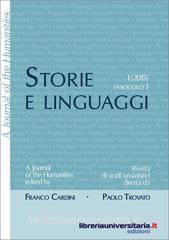
Storie e linguaggi
- Data di Pubblicazione:
- 21 settembre 2015
- EAN:
1242173415017
- Pagine:
- 151
- Formato:
- Protezione:
- DRM Adobe
- Dimensione:
- 603.71 Kb
Contenuti
Editoriale
Articoli
In the light of some recent books (Koselleck, Windschuttle, etc.), this essay discusses the problem of the significance of history.
The paper discusses the meaning (and the shifts of meaning) of “antichi” and “moderni” in a series of Italian medieval and Renaissance texts.
The paper concerns the famous letter of the monk Ilaro to the chieftain Uguccione della Faggiola, copied by Boccaccio in his Zibaldone Laurenziano 29,8. A closer examination of archival documents and chronicles shows why it is not possible to establish connections between Uguccione, his family and the monastery of Santa Croce del Corvo where Ilaro lived and which, according to the letter, Dante is supposed to have visited in 1314 or 1315.
Inspired by a recent paper on the meaning of “Cimabue”, the author offers possible conjectures concerning ancient personal names formed with the words “cima” or “cimare”.
A hundred years separate two of the most successful masterpieces of English Gothic Fiction: The Monk (1796) by Matthew Gregory Lewis and Dracula (1897) by Bram Stoker. The significance of this circumstance goes beyond mere chronological coincidence and is revealing of a closer connection between the two texts.
Such a connection, made up of a network of allusions, echoes, anticipations and cross-references, derives from a specific set of narrative situations that The Monk presents and that Dracula redefines in order to reflect new and different axiologies.
These situations focus on the motif of the Sleeping Beauty and its variations, a narrative topos whose morbid connotations both novels emphasize in a typically Gothic manner.
The analysis of the ways in which Lewis and Stoker make up this motif sheds light on the dialectical relationship connecting the two texts. With specific reference to Dracula, it provides as well a new interpretative perspective based on a metaliterary reading of Stoker’s novel, of the dark desires and evil pleasures it evokes one hundred years after Lewis’s The Monk.


